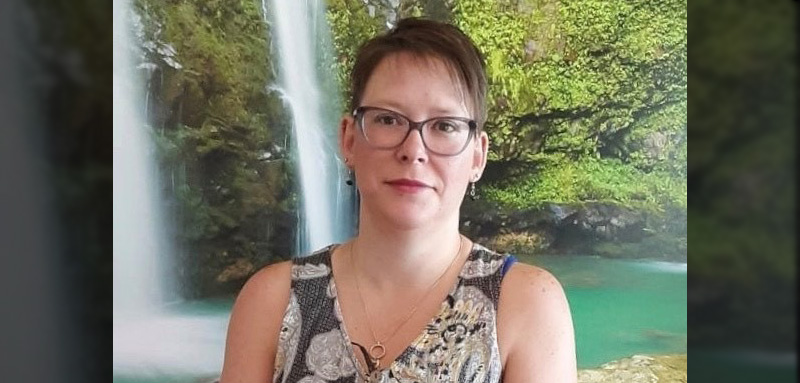Physical therapist Tanya Couture remembers catching a falling patient. And feeling something “snap’ in her back.
The career-ending injury in 2006 set Couture, then 27, on a quest to find pain relief. Couture tried months of physical therapy. An MRI performed at Mayo Clinic in 2009 revealed a complete rhomboid muscle tear in her upper right back. Unfortunately, the accumulation of scar tissue made it impossible to surgically repair the tear without damaging surrounding muscles.
Saddled with a 10-pound weight restriction, life was difficult for Couture who resided in Valley City, N.D., with her husband, Chad, and their two young children. On a scale of one to 10, her pain was an eight. She fell into a hard depression.
“Pain sucks the life out of you,” Couture says.
Couture earned a bachelor’s degree in social work from Bresnia University in 2012. When work-related driving proved too painful for Couture, her husband purchased a clothing store in 2013 for her to manage.
Throughout the years, Couture has consulted with 13 different doctors, receiving trigger point injections, cortisone injections and numerous nerve and spinal blocks. Since 2011, her monthly prescription drug bill has averaged $3,000. And for the past seven years, she’s received trigger point injections every 11 weeks, roughly $8,000 each visit. Thankfully, insurance covered most of it.
Opioids provided meager relief while wreaking havoc in her stomach, liver, eyes, kidneys and bowels. When Couture’s eyesight became threatened, she determined to find a drug-free solution. As a new grandmother, she wanted to see her granddaughter grow up.
Friends suggested the Center for Pain Medicine in Fargo and Couture researched it online. She was almost deterred by the painful 60-minute drive from Valley City. But Couture’s desire to get off the opioids was stronger than her dread of pain.
In October 2019, Couture met with Center’s Dr. Dustin Goetz, a board-certified anesthesiologist and interventional pain physician. The Center, founded by Dr. Majid Ghazi in 2014, promotes the development and practice of safe, high-quality, and cost-effective interventional pain management procedures for diagnosis and treatment of spine and joint-related pain disorders.
Goetz performed a thorough examination and recommended wireless periphery nerve stimulation. In this outpatient procedure, one or two wires with four to eight electrodes are implanted near the damaged nerve to interrupt pain signals. Goetz explained Couture would need to modify her lifestyle for the treatment and continue to follow the 10-pound weight restriction.
“Wireless peripheral nerve stimulation is a novel technique to relieve pain caused by a damaged peripheral nerve–such as intercostal, dorsal scapular, ilioinguinal, among others–resulting in chest wall pain, back pain or pelvic pain,” Ghazi says. “The procedure is very safe. The effect is almost immediate, and the success rate is high.”
A trial is performed to determine whether it will bring the desired results. Couture would need to be off oral pain medications for three months prior to the trial. After she was drug-free for four weeks, Goetz performed a nerve block to determine which nerves innervated her right rhomboid area.
“He was the first doctor who looked at and targeted the problem,” Couture says.
Couture underwent the trial in January 2020 in the Center’s in-house operating room in a sterile environment. Staff from Stimware, the company that manufactures the device, programmed the equipment.
In the procedure, wire-like electrode leads are placed through a needle into the skin next to the damaged peripheral nerves. The electrode, or stimulator receiver, works with a wearable antenna, which is clipped to clothing, next to the skin. The wearable antenna sends wireless electrical pulses through the skin and into the stimulator receiver. The receiver, in turn, sends rapid electrical pulses to the nerves that feel like mild tingles. These pulses intercept and block pain signals. The amount of stimulation can be adjusted through a controller attached to the wearable antenna.
Goetz encouraged Couture to try things that she had not been able to do before. Couture shopped for two hours, went bowling (within the weight restriction), and cut her own steak. All without pain.
On February 10, 2020, Couture underwent the implantation. Today, Couture possesses stamina to operate their family businesses, and cherishes watching her granddaughter’s growth.
“It’s unbelievable,” Couture says. “I literally thought living in pain was my destiny. It’s given me a whole new outlook.”
“Some days are hard; don’t get me wrong,” she adds.
Even so, Couture says, “This little piece of equipment could be life-changing for a lot of people.”
Read more patient stories.
 Can You Order Xanax Online Legally Online Doctor Xanax Prescription Buying Xanax Online Uk Order Alprazolam Cheap Buy Alprazolam Powder Buy Discount Xanax
Can You Order Xanax Online Legally Online Doctor Xanax Prescription Buying Xanax Online Uk Order Alprazolam Cheap Buy Alprazolam Powder Buy Discount Xanax


Recent Comments